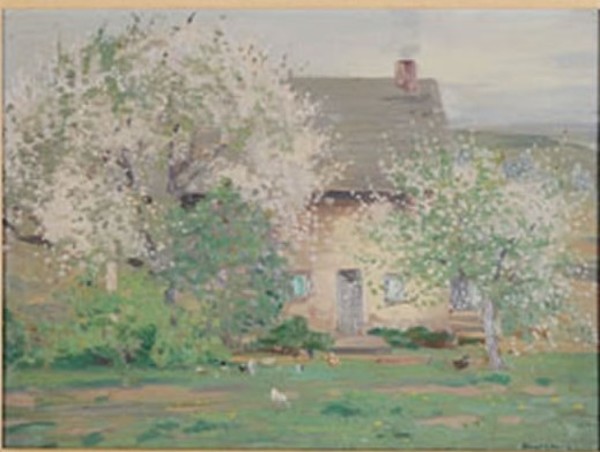-
Artist: Eliot Candee Clark (American, 1883-1980)
“Son of landscape painter Walter Clark and Jennifer Woodruff Clark, a student of psychic phenomena, Eliot Clark was a precocious artist who became a landscape painter in the late American Impressionist style. Moving to Albemarle, Virginia in 1932, he was one of the few Impressionist* [sic] artists of the Southern states” (1).
“Eliot Candee Clark, born in 1883 in New York, was a precocious artist - he exhibited two pieces at the New York Water Color Club when he was only nine years old; at age 13 exhibited with the National Academy and the New York Water Color Club; by 1912 he had won national painting awards; and by 1916 was writing books on American artists as well as the history of the National Academy” (2).
“Between 1904 and 1906, Clark studied in France in Paris and Giverny, and in London he saw the impressionist work of James Whistler. He wrote to his father about the Whistler Exhibit stating that some of Whistler's work impressed him, ‘not so much in the handling, but in the use of color, and subtle arrangement of line and balance of masses.’ He engaged in a "walking tour" of Europe with a fellow artist whom he met in earlier in Paris. They visited many of the major galleries in Holland and then traveled through the Alps, finally reaching Venice on August 10, 1906. In Venice, he produced some Whistlerian style pastels similar to the ones he had seen in the Whistler Exhibition” (3).
“He returned to New York in 1906, and a year later took a studio in the Van Dyke Studio Building on Eighth Avenue. There working in the building were a diversified group of painters such as the Tonalist* artists Bruce Crane and Cullan Yates; the Impressionists were represented by Edward Dufner and Karl Anderson” (1).
“Because of his interest in eastern philosophy he traveled in the late 1930s to India for two years where he painted the Himalayas and also to Tibet. He also painted in the Deep South in Charleston and Savannah where he set up his easel on the waterfronts and among oak groves. In 1944 rejuvenated by a second marriage and election to the National Academy of Design, Clark returned to the Connecticut countryside to paint landscapes. In the late 1940s Clark began to summer in Virginia where he ultimately returned for good in 1959, settling with his new wife in the ‘lovely hills’ near Albemarle, Virginia” (3).
“He continued to paint almost to the end of his life, enjoying the solitude and peace of the surrounding environment where he could relate to canvas the subtleties of nature as only he could” (2).
“Eliot Candee Clark passed away in 1980” (3).
Reference:
1.
Askart Staff. Eliot Clark [internet]. [cited 2015 Sept 5]. Available from: http://www.askart.com/artist_bio/Eliot_Candee_Clark/6959/Eliot_Candee_Clark.aspx
2.
Bodega Bay Heritage Gallery Staff. Eliot Candee Clark [internet]. [cited 2015 Sept 5]. Available from: http://www.bodegabayheritagegallery.com/Clark_Eliott_Candee_.htm
3.
Dunbier, L. Eliot Candee Clark (Am. 1883-1980) [internet]. [cited 2105 Sept 5]. Available from: http://www.daviddike.com/artists/340-clark-eliot.html
